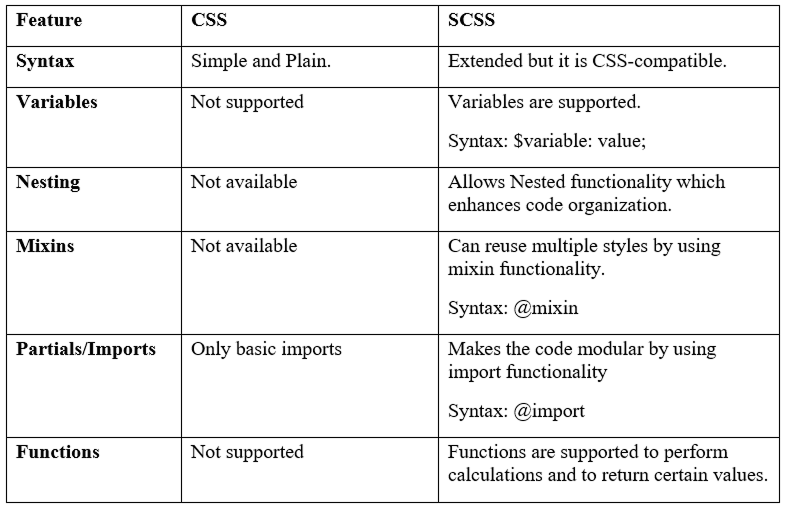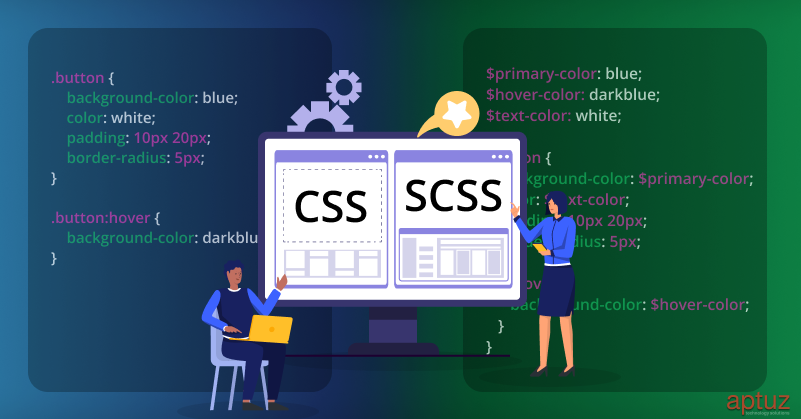In the ever-evolving world of web development, the tools we use significantly impact both workflow efficiency and project quality. Cascading Style Sheets (CSS) has long been the standard for styling, but as projects grow in complexity, developers are increasingly turning to SCSS (Sassy Cascading Style Sheets) to enhance efficiency and maintainability. SCSS extends CSS with powerful features like variables, nesting, and mixins, allowing for cleaner, more modular code. In this blog, we’ll compare CSS and SCSS, explore SCSS features, and discuss why modern developers prefer it over traditional CSS.
CSS Features and its Limitations
Cascading Style Sheets (CSS) is a fundamental technology in web development that gives developers control over the presentation and layout of web pages. CSS separates content from design, CSS brings more flexibility and efficiency to the development process by using plain and simple syntax. It allows developers to define styles for HTML elements like headers, paragraphs, covering everything from colors, fonts, spacing and overall layout. This separation of content and styling improves maintainability.
Key Features of CSS
- Separation of Content and Presentation: CSS enables a clean separation of HTML structure and styling. This keeps code organized by storing styles in external .css files, reducing clutter in HTML.
- Reusability: Styles defined in a single CSS file can be reused across multiple HTML pages, making it easier to maintain a consistent design. Linking stylesheets with the <link> tag allows for a streamlined workflow. Most developers choose external CSS because it keeps the code easy to read, and more manageable as projects become complex.
- Responsive Design: CSS provides flexible layouts that adapt to different screen sizes, ensuring a consistent experience across mobile, tablet, and desktop devices.
Limitations of CSS
1. Complexity in Large Projects: As projects scale, managing extensive stylesheets becomes increasingly difficult. Without proper structure and organization, CSS files tend to become overly complex and cluttered.
Developers often struggle with redundancy, where the same styles are repeated in multiple places, making maintenance cumbersome. Debugging and modifying such stylesheets require extensive effort, leading to inefficiencies in large-scale projects.
2. Limited Functionality: CSS lacks built-in features like variables, functions, and conditionals that are common in programming languages. This limitation makes it challenging to implement dynamic styling.
For instance, if a project requires a consistent color scheme across multiple components, every instance of the color must be manually updated when changes are needed. This manual approach increases the likelihood of errors and inconsistencies, making CSS less efficient for large projects.
3. Browser Compatibility Issues: Different web browsers interpret CSS rules in varying ways, leading to inconsistent styling across platforms. A layout that appears flawless in Google Chrome may render differently in Mozilla Firefox or Safari.
Developers must often rely on vendor prefixes (-webkit, -moz, -ms) or custom fixes to ensure consistent behavior. Despite CSS advancements, browser-specific quirks still necessitate additional testing and adjustments, adding to development time.
4. Performance Concerns: Large CSS files with redundant and unused styles can slow down website performance. As browsers must parse and apply all styles before rendering a page, excessive CSS rules increase page load times, particularly on resource-limited devices. Inline styles and deeply nested selectors further degrade performance by increasing rendering complexity.
Optimizing stylesheets by removing unused rules, compressing files, and utilizing best practices is crucial for maintaining smooth and efficient web applications.
An Overview of SCSS
SCSS (Sassy Cascading Style Sheets) is an advanced extension of CSS (Cascading Style Sheets) that introduces programming-like features to simplify and optimize styling workflows. It is one of the syntaxes of Sass (Syntactically Awesome Stylesheets) and is fully compatible with regular CSS, making the transition seamless. Since SCSS is a superset of CSS, any valid CSS code also works as SCSS, making the switch from regular CSS to SCSS easy for developers.
SCSS functions as a preprocessor, meaning the code must be compiled into standard CSS before browsers can interpret it. By allowing developers to write more structured and concise code, SCSS is then compiled into standard CSS that browsers can read. The main benefit of using SCSS is how it streamlines the workflow and minimizes repetitive coding tasks.
Key Features of SCSS
1. Variables: SCSS allows defining variables for colors, fonts, and other properties. Instead of manually updating repeated styles, developers can modify a single variable, and all associated styles update automatically.
SCSS defines a variable by using the symbol ‘$’ followed by the variable name and variable value. Interpolation is a feature that allows you to insert the value of variables or expressions into selectors, property names, or property values within your SCSS code. The syntax for interpolation is “#{}”

2. Nesting: SCSS enables nesting selectors within parent elements, making stylesheets more readable and structured.
Suppose we have some HTML code as follows:
<div class="container"> <h1 class="header">Title</h1> <p class="content">Content 1</p> <p class="content">Content 2</p> </div>
We have one container and it is having one heading and two paragraphs. Now we can apply styling to this container by using SCSS Nesting.

3. Operators: It lets developers perform calculations, comparisons, and logical operations right in the code. This feature makes styling easier and enables the creation of dynamic styles that can change based on variable values.

4. @rules and control directives: In SCSS, @rules are special instructions that give you more control and flexibility in how your styles are handled. These rules help you create dynamic, powerful stylesheets.
- @extend: Lets one selector take on the styles of another, making it easier to avoid repeating code and keeping things more streamlined.

- @function: Used to define a function in SCSS to perform operations and calculations and in result to return a value.

- @mixin and @include: @mixin is used to reuse styles that are used frequently in order to
avoid code repetition and @include is used to include a mixin in the current selector where
we are going to use that mixin.

- @if, @else, @else if: In SCSS there are some conditional statements like if, if-else which helps
to apply the styles based on certain conditions.
@if example:

@else, @else if example:

- @for: The @for loop is used whenever there is a need to apply styles in repetitive way which increases efficiency.

- @while: The @while loop is same as @for loop, but it will apply the style in a repetitive way until a condition gets true.

- @each: The @each rule allows you to loop through a list or map to apply styles.

Advantages of using SCSS
SCSS offers several benefits that make stylesheets more efficient and easier to maintain:
- Increased Productivity: SCSS minimizes repetitive tasks with features like mixins, making code more efficient and reducing development time.
- Better Code Organization: Nesting and partial imports allow for a cleaner, modular approach to styling, improving maintainability in larger projects.
- Improved Maintainability and Readability: By using variables, mixins, and functions, SCSS makes stylesheets more readable and easier to update without extensive modifications.
- Powerful Features: SCSS extends CSS with programming-like functionality, allowing for advanced styling logic that is impossible in plain CSS.
Key differences Between CSS and SCSS:

Practical Examples: CSS vs SCSS:
In this Example we can see the example of Nesting. Means how we can apply to the parent and its child fields in CSS and SCSS.
Consider a "container" division with 2 child division - "header" and "content"
. header - should have 24px font-size
. content - should have 16px font-size
CSS Approach:
.container .header {
font-size: 24px;
}
.container .content {
font-size: 16px;
}
In CSS, we can apply style by using selectors separately ".container .header" and ".container .content"
SCSS Approach:
.container {
.header {
font-size: 24px;
}
.content {
font-size: 16px;
}
}
In SCSS, we can apply the same styles by using nesting feature which provides more readability and maintainability. It makes the code more structured, reducing redundancy.
Why Modern Developers Prefer SCSS
- Saves Time and Effort: By using features like Variables, mixins, nesting and functions, SCSS reduces the amount of code written by the developers which improves maintainability and enhances efficiency0.
- Improves Code Organization: SCSS provides functionality like partials and imports. Imports and partials help to split styles into smaller files and import them wherever needed.
- Cleaner and More Readable Code: Code in SCSS similar and compatible to CSS, but in addition it adds structure and clarity by using features like nesting and mixins.
- Easily Scalable: For larger projects, SCSS is the preferred choice because it increases maintainability by its features like mixins, @rules.
Conclusion
CSS remains essential for web development, but as projects grow in complexity, maintaining plain CSS becomes cumbersome. SCSS offers enhanced capabilities with variables, nesting, mixins, and functions, making code more structured, reusable, and scalable.
So, adapting to SCSS not only makes your code look more cleaner and organizable but enhances efficiency by using @rules, mixins. It also makes code look more modular and also saves time to reuse the code by using mixins and functions.
In conclusion, CSS will be fundamental to web development. SCSS is clearly a more powerful and adaptable tool for today’s developers. Its features improve readability, maintainability, and scalability, making it the perfect choice for developers looking to simplify their workflow. Switching to SCSS helps you stay competitive, efficient, and prepared for the challenges of complex web projects.

